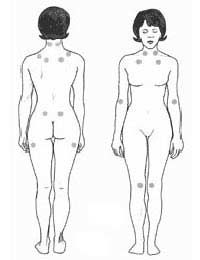Joint Hypermobility and Fibromyalgia Syndrome

There seem to be links between fibromyalgia syndrome and joint hypermobility syndrome – both can include symptoms of widespread pain, and hypermobility syndrome seems to be more common in people with fibromyalgia syndrome than in the general population.
What is Joint Hypermobility?
People with hypermobile joints are able to move their joints, or bend or stretch their bodies, much further than the rest of the population. Joint hypermobility is often inherited, and about 5-15% of the population has hypermobile joints (this can increase to as much as 38% in Middle Eastern women).In some people, hypermobile joints have no symptoms other than increasing their bodies' flexibility, and it can be used to an advantage, for example in dance or sport, or in playing an instrument. However, in people with joint hypermobility syndrome, the hypermobility of the joints can lead to pain and other symptoms after excessive or repetitive movement.
Other Symptoms of Joint Hypermobility Syndrome
As well as having hypermobile joints, people with joint hypermobility syndrome may also have skin that is thinner and more fragile than other people's skin, and they may bruise more easily. Young people with joint hypermobility syndrome may develop stretch marks on their skin during periods of fast growth.Another symptom is known as ‘proprioceptive impairment’, where patients don’t ‘know’ where they are physically in space, which can make them less stable and prone to falls, and awkward or clumsy.
Some people with joint hypermobility syndrome (possibly up to half) are more sensitive to pain than the rest of the population, and have pain at a number of sites across their bodies. Other symptoms can include low blood pressure when standing up, light-headedness and fainting, tachycardia (fast heart rate), anxiety, panic attacks, tiredness and heat intolerance.
Joint Hypermobility Syndrome and Fibromyalgia Syndrome
Some scientific studies have suggested links between joint hypermobility syndrome and fibromyalgia syndrome. A Canadian study showed that almost half of their patients with joint hypermobility syndrome also had widespread pain at multiple sites. A study in Spain also linked fibromyalgia syndrome and joint hypermobility syndrome - in the study, 27% of the women with fibromyalgia syndrome had hypermobile joints, in comparison with 11.4% of women with other rheumatological disorders. In a study in Israel in children, 81% of the children with fibromyalgia syndrome also had joint hypermobility syndrome, and 40% of the children with joint hypermobility syndrome also had fibromyalgia syndrome.Not all studies show a connection between fibromyalgia syndrome and joint hypermobility syndrome, suggesting that joint hypermobility syndrome could just be misdiagnosed as fibromyalgia syndrome – this shows that more research is needed.

Re: Numbness and Tingling in Fibromyalgia Syndrome
I'm having numb and tingling on my right side of face from corner of mouth to high cheek bone...........…
Re: Benefits and Allowances for Fibromyalgia Sufferers
I have fibromyalgia I started with it at the age of 5 years old I got burnt by a chip at pat the age…
Re: Benefits and Allowances for Fibromyalgia Sufferers
Having read all the comments here. I’m very discouraged. I don’t think I’ll be putting myself through…
Re: Chronic Fatigue and Fibromyalgia
I have not been diagnosed with fibromyalgia as such. The doc thinks it is, I have been put on antidepressants. To quote him ,…
Re: Reading Aids and Fibromyalgia Syndrome
Eeeeer.
Re: Being a Parent With Fibromyalgia
I'm really struggling I have my 2 grandsons full-time or thy would of ended up in the system been 18 month now thy are now 2…
Re: Dealing With Fatigue Day by Day
Hi I've had FM for years now, I've always worked but now ive gotten so bad with pain increasing and being on max dose, i work…
Re: Benefits and Allowances for Fibromyalgia Sufferers
Over 20 years ago after mri blood test I was told I had fibromyalgia, I was working at the time until…
Re: Benefits and Allowances for Fibromyalgia Sufferers
I work part time and am a carer in receipt of carer's allowance for my hubby who is on state pension.…
Re: Fibromyalgia in Old Age
I don't know if I have fibromyalgia but 3 months ago I had a migraine which led to chronic neck ache. Now I have pain in various parts of…